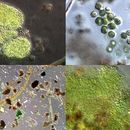铜绿微囊藻(學名:Microcystis aeruginosa)是一種出現在淡水中的藍菌,會產生有害藻華,具有一定的生態學與經濟重要性[1][2]。铜绿微囊藻是在優養化的淡水中最常見的有毒藍菌藻華來源[2]。
特徵
如同其學名顯示的,微囊藻屬的特徵為小型的細胞,細胞大小僅有3至8微米[3],且其外沒有鞘包覆[4]。細胞常聚集成肉眼可見的群落,這些群落本為圓形,經過時間發展可能會產生孔洞並呈不規則形狀。原生質體的顏色是淺藍綠色,但因細胞中具有充滿空氣的囊泡在光下可能呈暗色,這是光學顯微鏡下微囊藻的鑑別特徵之一。囊泡提供微囊藻足夠的浮力,使其停留在有足夠光線和二氧化碳提供生長的水層。
生態
铜绿微囊藻較偏好高溫,但毒性與最高生長率不一定有關聯,在實驗室培養中,攝氏32度具有最高的生長率,但毒性最強的溫度是攝氏20度。溫度低於攝氏15度時其生長會被顯著的抑制。除了毒素外,微囊藻形成藻華時淡水溶氧量的顯著降低也會導致水中動物的死亡[5]。
一種水生被子植物聚藻可以產生鞣花酸、沒食子酸、連苯三酚和兒茶素,這些聚酚化合物可產生化感作用,對铜绿微囊藻的生長產生抑制[6]。
毒素
铜绿微囊藻可以產生神經毒素脂多糖[7]與肝毒素(英语:hepatotoxins)微囊藻素(英语:microcystins)。微囊藻素是一些環狀非核糖体多肽(英语:Nonribosomal peptide)的合稱,由脱氢丙氨酸(英语:dehydroalanine)衍生物和ADDA氨基酸(英语:ADDA (amino acid))等非蛋白胺基酸組成,可強烈抑制第一型與第二型蛋白質磷酸酶,對動植物都有毒性,對肝臟的毒性很強,也和全脂炎(英语:Pansteatitis)有關[8]。
經濟重要性
由於在理想的環境下铜绿微囊藻可以持續產生對肝有害的微囊藻素,其為飲用水汙染的來源之一[9],且這種毒素對熱的抗性高,甚至以活性碳吸附、加入氯或臭氧消毒也無法完全消除[3]。對經濟的影響包括為了減輕毒素需要在淨水上花費的額外成本,和發生有害藻華的河湖需暫時封閉對當地旅遊業造成傷害[10]。
也有研究顯示铜绿微囊藻可以產生2,6-二叔丁基對甲酚,這種物質主要在食品添加劑中被用作為抗氧化劑,在工業上也具有許多用途[11]。
相關條目
參考資料
-
^ Chroococcales. EOL. [24 June 2011].
-
^ 2.0 2.1 Oberholster, PJ. Microcystis aeruginosa: souce of toxic microcystins in drinking water (PDF). Microcystis aeruginosa: souce of toxic microcystins in drinking water. African Journal of Biotechnology March 2004 Volume 3 pp 159-168. [24 June 2011].
-
^ 3.0 3.1 鄚朝陽. 水庫水質解析/恐怖微囊藻毒 喝了恐罹肝炎. 聯合報. 2012-08-13 [2016-07-21]. (原始内容存档于2012-08-19) (中文(繁體)).
-
^ Cyanobacteria: Microcystis. The Silica Secchi Disk. Connecticut College: The SilicaSecchi Disk. [24 June 2011]. (原始内容存档于26 三月 2008). 请检查
|archive-date=中的日期值 (帮助) -
^ Padmavathi, P; K. Veeraiah. Studies on the influence of M. aeruginosa on the ecology and fish production of carp culture ponds. African Journal of Biotechnology. 6/04/2009, 8 (9): 1911–1918 [24 June 2011]. 引文使用过时参数coauthors (帮助); 请检查
|date=中的日期值 (帮助) -
^ Myriophyllum spicatum-released allelopathic polyphenols inhibiting growth of blue-greenalgaeMicrocystis aeruginosa. Satoshi Nakai, Yutaka Inoue, Masaaki Hosomi and Akihiko Murakami, Water Research, Volume 34, Issue 11, 1 August 2000, Pages 3026–3032, doi:10.1016/S0043-1354(00)00039-7
-
^ Mayer, Alejandro M. S.; Jonathan A. Clifford. Cyanobacterial Microcystis aeruginosa Lipopolysaccharide Elicits Release of Superoxide Anion, Thromboxane B2, Cytokines, Chemokines, and Matrix Metalloproteinase-9 by Rat Microglia. Toxicological Sciences. 2, 121 (1) [25 June 2011]. 引文使用过时参数coauthors (帮助); 请检查
|date=中的日期值 (帮助) 引文格式1维护:日期与年 (link) -
^ Barnett A. Rattner, Glenn H. Olsen, Peter C. McGowan, Betty K. Ackerson, and Moira A. McKernan. Harmful Algal Blooms and Bird Die-offs in Chesapeake Bay: A Potential Link?. USGS-Patuxent Wildlife Research Center and Fish and Wildlife Service, Chesapeake Bay Field Office.
-
^ Cyanobacterial Toxins: Microcystin-LR in drinking water (PDF). Background document for development of WHO Guidelines for Drinking Water Quality. World Health Organization (WHO). [24 June 2011].
-
^ Somek, Hasim. A Case Report: Algal Bloom of Microcystis aeruginosa in a Drinking-Water Body, Eğirdir Lake, Turkey (PDF). A Case Report: Algal Bloom of Microcystis aeruginosa in a Drinking-Water Body, Eğirdir Lake, Turkey. Turkish Journal of Fisheries and Aquatic Sciences. [27 June 2011]. (原始内容 (PDF)存档于4 十月 2011). 请检查
|archive-date=中的日期值 (帮助) -
^ Babu B, Wu JT. Production of Natural Butylated Hydroxytoluene as an Antioxidant by Freshwater Phytoplankton (PDF). Journal of Phycology. December 2008, 44 (6): 1447–1454. doi:10.1111/j.1529-8817.2008.00596.x.
物種識別信息 

